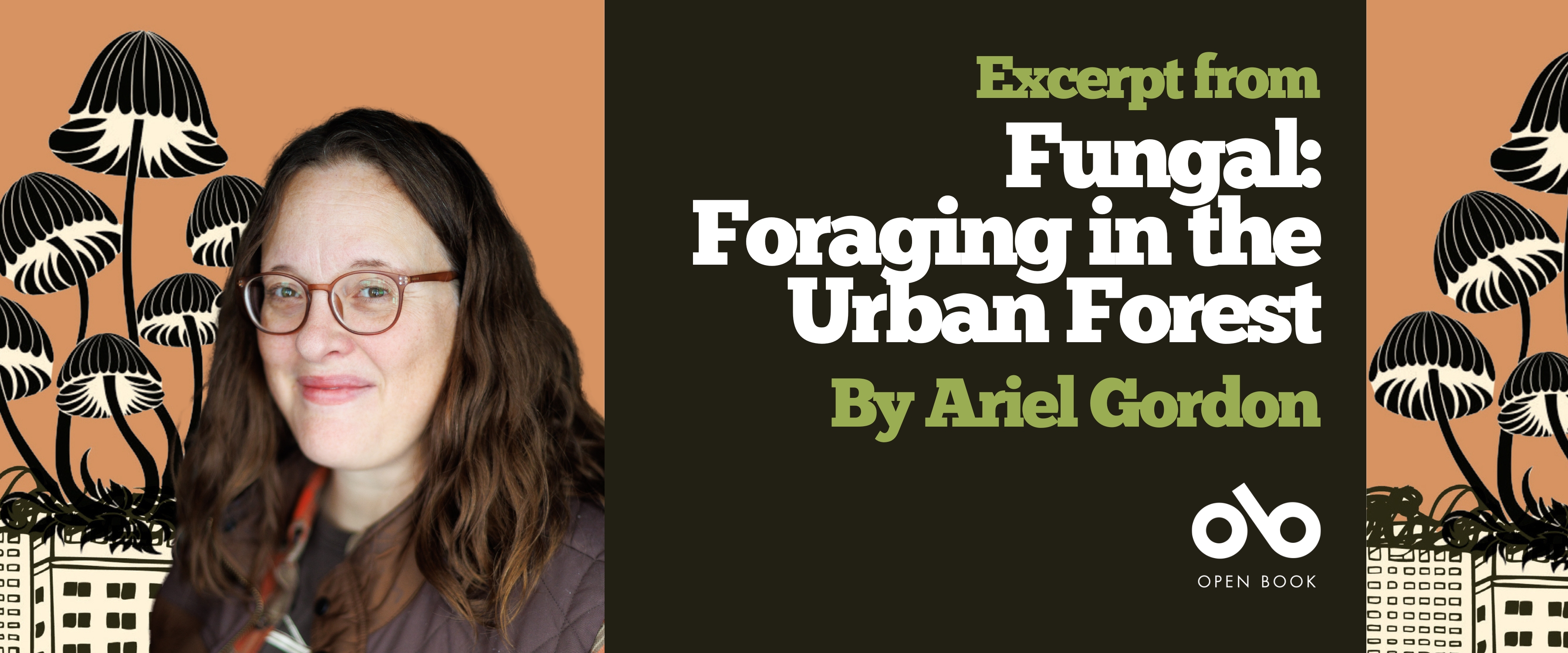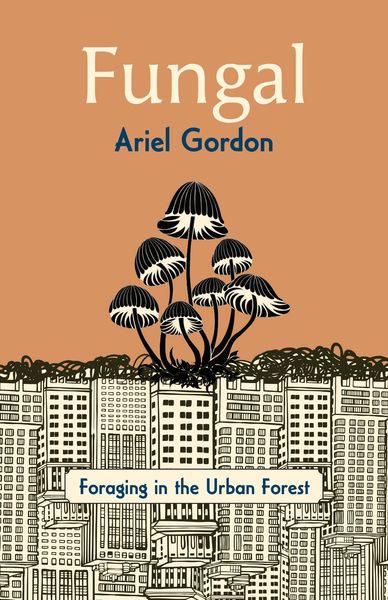Read an Excerpt from Fungal: Foraging in the Urban Forest by Ariel Gordon
Though many of us live in urban surroundings, and may well be caught up in all of the concrete, glass, and metals that make up our neighbourhoods and streets, the natural world is always there, beneath and behind it all.
Ariel Gordon knows this well, and she takes the reader on a journey through urban and urban-adjacent wilds using mushrooms as her guide. Her new nonfiction collection, Fungal (Wolsak & Wynn), is a wide-ranging exploration of the place that mushrooms and other fungal finds take up in our world. With poetry and humour, the author shows us through the many strange and sometimes harrowing ways that mushrooms have been gathered, studied, and used. And also delves into the way that mushrooms weave beautifully through an interconnected ecosystem.
We're delighted to share some of this fascinatingly wild collection today on Open Book, free for our readers.
Excerpt from Fungal: Foraging in the Urban Forest by Ariel Gordon
Eating My Words
In July 2022, I traded a copy of my book Treed to Shel Zolkewich, writer/bon vivant, for an armful of oyster mushrooms (Pleurotus sp.) growing from a broken tree on her property in Meleb, Manitoba, and some farm-fresh eggs.
I was thrilled that I’d somehow managed to turn my book about trees and mushrooms into mushrooms that I could eat (with a side of eggs . . .), instead of stupid money.
In the days after the trade, it became important to me that not a scrap of the food for which I’d bartered my book would go to waste. Eggs are not hard to consume – I have a hard-boiled or fried egg every morning and my daughter uses them in her baking. But oyster mushrooms spoil quickly, so I worked hard to eat every morsel of those oyster mushrooms, cleaned and sliced and cooked in oil.
I really liked the idea that I’d traded a container full of ideas, that I’d had the time to write down and rearrange those ideas for a bag full of mushrooms but also the time to find and pick those mushrooms.
The mushrooms themselves may not have lasted long, but the pleasure that I had traded my book for mushrooms lingered for weeks, long after I’d eaten, digested and excreted them.
I’d been working with Tom Nagy on a Zoom presentation for the Wolseley Community Garden and he’d already flushed the winter 2021 with oyster mushrooms and lion’s mane mushrooms that I’d somehow managed to grow myself. (As the youth say: 10/10, would recommend!)
Your CanLit News
Subscribe to Open Book’s newsletter to get local book events, literary content, writing tips, and more in your inbox
And so, in the weeks after my trade with Shel, I asked Tom if he could help me feed my book to his mushrooms, by which I meant encourage them to grow onto/between its pages. My goal? To eat the mushrooms that had eaten my book.
I wanted to eat my own words.
When I’m walking in the woods, when I’m surrounded by trees and mushrooms, lichen and moss, ferns and wildflowers, I feel connected to the world.
Like someone who’s drunk or high, I’m terrible company.
I mostly just point out mushrooms growing on or under trees – even going so far as to go a squat next to them, touching them gently – while murmuring about how happy I am. Over and over.
Like a child, I have terrible instincts when it comes to mushrooms. I’ll wade into muddy ditches or into the bush, without thinking of my shoes/clothes. I’ll sit directly on poison ivy if there’s a mushroom I want to look at or photograph. I’ll get covered in mosquito bites or turn myself into a climbing wall for wood ticks, despite a fulsome knowledge of West Nile or Lyme diseases.
I am particularly good at getting burrs in my hair.
I actually like getting filthy – it feels like I’ve had a proper adventure. Also, what’s the point of clean clothes if not to get them dirty?
So the idea of “dirtying” a copy of Treed – a book about trees made of trees – made me happy.
Inoculating Treed with mushroom spawn was like making a lasagna or a layer cake.
When I arrived at Tom’s apartment, the book was splayed, face down, in a tub of water, secured by three mason jars also filled with water.
According the Bookmark Alignment Chart, which rates the various ways people mark their places in books, leaving a book face down is Neutral Evil. I’m frequently Neutral Evil and even sometimes the worst of the worst, Chaotic Evil, which is dog-earing pages.
The book had been in Neutral Evil for a full day, in preparation for inoculation.
Next to the tub was a heaping bowl of wheat kernels that had been inoculated with oyster mushroom spawn. If you didn’t look closely, you’d think that it was high-fibre cereal or hardcore granola or even a deconstructed puffed wheat square.
Tom knows this is oyster mushroom spawn but doesn’t remember exactly what kind it is. He produces several varieties of oyster mushroom grow kits from strains he purchases, including black pearl king oysters and pink oysters, which are a beautiful peachy pink. He also developed a strain of his own in 2019, which he calls the Wolseley Oyster.
“These beauties were cloned from a wild oyster growing from an elm stump in the Wolseley neighbourhood of Winnipeg,” Tom wrote in an Instagram post introducing the strain. “A tissue sample was taken from the wild mushrooms and cultured on agar for several generations before being transferred to liquid culture and grain spawn for long term storage.”
I was hoping that what we’d infested my book with was the Wolseley Oyster, just because that dovetailed with the things I’d written about. Trees and mushrooms, as opposed to this book’s focus, mushrooms and trees. So different!
While we worked, Tom commented he had been nervous about so mistreating a book, but I told him books are just containers for ideas. I tried to explain how exciting the idea of reusing that container – like a margarine tub – was for me.
Manitoba is home to six large historical populations: the Cree, Anishinaabe and Métis people, and settler populations of Jewish, Ukrainian and Mennonite people. This is, of course, in addition to the dominant French and English cultures that colonized Canada. So I grew up buying and eating frozen perogies, using Yiddish-isms like “shmutz” or “klutz” in everyday speech, and wearing Métis “ceinture fléchées” during Festival du Voyageur, our Franco-Manitoban winter festival. So understand that I mean no disrespect when I tell you that the local way to refer to repurposed margarine tubs is “Ukrainian Tupperware.” It speaks to the desire to use anything useful until it is worn out. I imagine the thought process of babas are as follows: “Why buy fancy plastic containers for food storage, for sending home leftovers with my grown children after Sunday dinner that I might never get back, when I can use a margarine tub?” I try to embody that lifestyle myself: use and reuse, gift and regift and don’t buy new unless I really need to. Like a margarine container that wasn’t designed for long-term storage of anything besides, say, margarine, my book wasn’t designed to grow mushrooms, but it will probably work.
We squeezed out the excess water and set the book on Tom’s workbench. And then, using a soup spoon, we spread a thick layer of myceliated grain every twenty pages or so. (The Bookmark Alignment Chart says that putting a leaf in a book to mark your place is Chaotic Neutral. Another version of the chart I found says that Chaotic Neutral is “leaves book open, face down, at last page read” and Chaotic Evil is “rips out each page once it’s been read.” In the world of the bookmark alignment meme, growing mushrooms on a book, where mushrooms eat the book, would probably be considered evil evil.)
Once we were done, we used three elastic bands to secure the bookshroom together, at least until the fungi had infiltrated and bound together the pages with mycelia. We put the final product in a big Ziploc bag and set it on the shelf with Tom’s other mushroom kits, waiting for the mushroom culture to completely colonize the book before transferring it into his fruiting chamber, which is an enclosed space with consistent air flow/moisture.
While Tom thinks we’ll be able to grow mushrooms on my book, he’s not exactly sure how things will progress: we might not get three flushes of mushrooms, for instance.
My main take-away from this session is that feeding a block of paper to mushrooms – as opposed to shredded cardboard or newspaper or woodchips or sawdust – is equivalent to a diet consisting entirely of potato chips.
_______________________________________________
Ariel Gordon (she/her) is a Winnipeg/Treaty 1 Territory–based writer, editor and enthusiast. She is the ringleader of Writes of Spring, a National Poetry Month project with the Winnipeg International Writers Festival that appears in the Winnipeg Free Press. Her previous work of nonfiction, Treed: Walking in Canada’s Urban Forests, was shortlisted for the Carol Shields Winnipeg Book Award. Gordon’s essay “Red River Mudlark” was second-place winner of the 2022 Kloppenburg Hybrid Grain Contest in Grain Magazine and other work appeared recently in FreeFall, Columba Poetry, Canthius and Canadian Notes & Queries. Gordon’s fourth collection of poetry, Siteseeing: Writing nature & climate across the prairies, was written in collaboration with Saskatchewan poet Brenda Schmidt and appeared in fall 2023.






